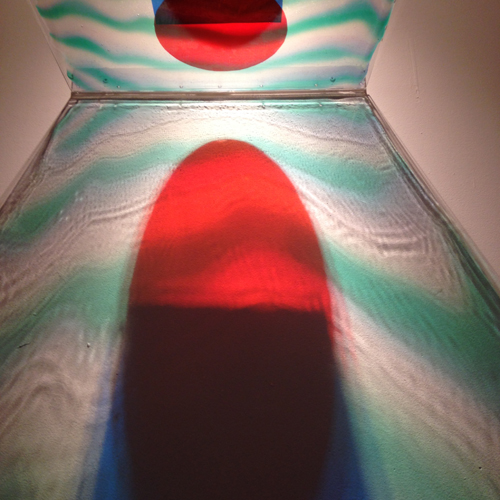Rethreadings
Randee Silv
December 2014

That reaction the other night. To align not dispute. I could’ve ignored yet another abstract stroke and returned to the street. But while there, somehow, I didn’t mind getting caught in their grip. They hit hard. I went up to the gallery’s second floor, then back down.
I guess one could opt to hide instead of being probed and poked. But where? Corners, top, bottom, left, right, middle, outskirts. All occupied. I watched as some wiggled for permanent release. “What are they about?” He turned hoping I would answer. I didn’t see any No Trespassing, Private Property or Stop signs posted. An early exit seemed unadvisable. Why would he want to anyway? Why look, if not to gamble?
Repetitions. There always are. But the usual boredom that could’ve set in, didn’t. Typical drips. Every day splashes. Motifs. Outmaneuvering moves inside of moves. Brief and extra long traversing lines, competent, wide, abrupt, loud, timid on juxtaposed panels of printed fabric. Bright sweeping colors forced to slow slightly across the crevices. Continuation never extinguished. Almost dizzifying. Simultaneous conflicts never let up.
No need to decipher defunct codes. Why bother? It was tiresome to categorize, compare and label. It made no difference where or when they were painted or why he’d left the figure behind. That was between him and his paint to approach surface as “Surprise,” “Mess” or “Dare as Beauty.” Elements recomposed themselves, fluctuating, fusing, randomly consolidating. I recomposed myself. I continued listening to the sound of painterly gestures, unabandoned, showering down.
*
Hilma af Klint’s name was on their press release; so I went. A piece of textured plexiglass had been placed at just the right height above a reading bench with a small fixture angled to stimulate vibrational intersecting forms of colored light that shifted between dimensions onto the wall. I sat down and soaked in its strange illuminating stillness that could almost have been channeling her.
On an adjacent shelf, among first editions he’d brought with him related to af Klint was Besant’s Thought-Forms, but I couldn’t resist picking up Ghosts of My Friends as he was telling the story of how it had been passed around during early 1900s parlour games. Feathered skeletons and eerie, puzzling shapes filled the pages revealing distorted eyes, flattened faces, someone seen, each with a name below. But then I noticed the instructions, “Sign your name along the fold with a full pen of ink and then double the page over without using blotting paper.” These pocket sized books had been published in response to the latest fad, collecting “ghost autographs.” One signed “Samuel Clemens” has even been auctioned off.
Another played for entertainment was Klecksographie (Blotto) where you had to descramble blotches and come up with your own verse. Or one from the publication Gobolinks, where guests wore costumes with both sides matching and had their ink spots & rhymes judged for prizes. Both were most likely sparked by the book of poetry written by the German doctor, spiritualist and poet, Justinus Kerner, though, his inkblots were not done for amusement. He believed that spirits were “condemned to remain in the darkness of his ink-well until they could use it as means to make themselves visible.”
In A New Method of Assisting the Invention in Drawing Original Compositions of Landscape (1785), the English painter Alexander Cozens discussed in detail how accidental stains could be adopted as catalysts after seeing how they’d evoked his students’ imaginations. When he learned that Leonardo da Vinci had already written about looking at old walls to stimulate “the scent of new thoughts,” Cozens emphasized that his own theory differed in that the active involvement of making deliberate, instantaneous marks was an essential element for an original composition to be be fully realized.
*
Les Contemplations 1856, Victor Hugo:
The dreamer’s hand vibrates, trembles…
On the page, when these characters come out—
Words, figures, terms of doubtful origin,
Visage of the invisible, shown by the unknown;
Made by whom? shaped by whom? sprung from the shadows.
“Victor Hugo is a Surrealist when he is not stupid” wrote André Breton in his Manifeste du surréalisme. Hugo’s ink tache drawings of smudges, spills, rubbings, foldings, coffee, soot and other concoctions fascinated Breton, especially their “power of suggestion” for unleashing the unconscious mind, but Hugo’s “spirit messages” and talking to the dead were of no interest to Breton.
*
Before I even opened the door to enter, air particles were voluntarily pulsating at unusual speeds. Paintings with a largeness, piercing, were intimately placed. Towering craters of impasto surfaces broadened by a reduced palette. Dense. Glistening. I was no longer grounded on the floor of the gallery.
The imagery that he had evoked before was not so obviously present. Or maybe it had all been tightly compressed into these integrated universes. Circling circles switching, fusing with rectangles, squares. Borderless edges did not swallow. Minute dabs of conversing light fill and absorb. Possibilities not pressured, only vast.
With titles like Mirror of Space, Always the Center, Square of Meditation, Transcendental Red, I could’ve leaned towards doubt, but in the presence of such precise balance, a gestural voice of solitude and action, I sank into each one sifting time as it unfastened in the last minutes before closing. A fullness so irresistible.
*
Albert Oehlen @ Skarstedt Gallery
Christian Sampson @ Jackie Klempay Gallery
Richard Pousette-Dart @Pace Gallery
